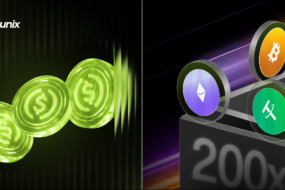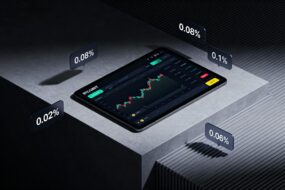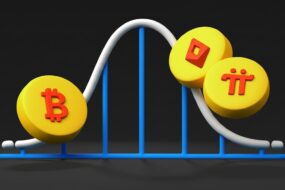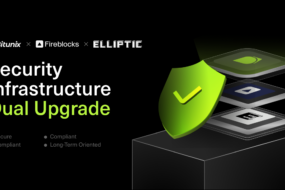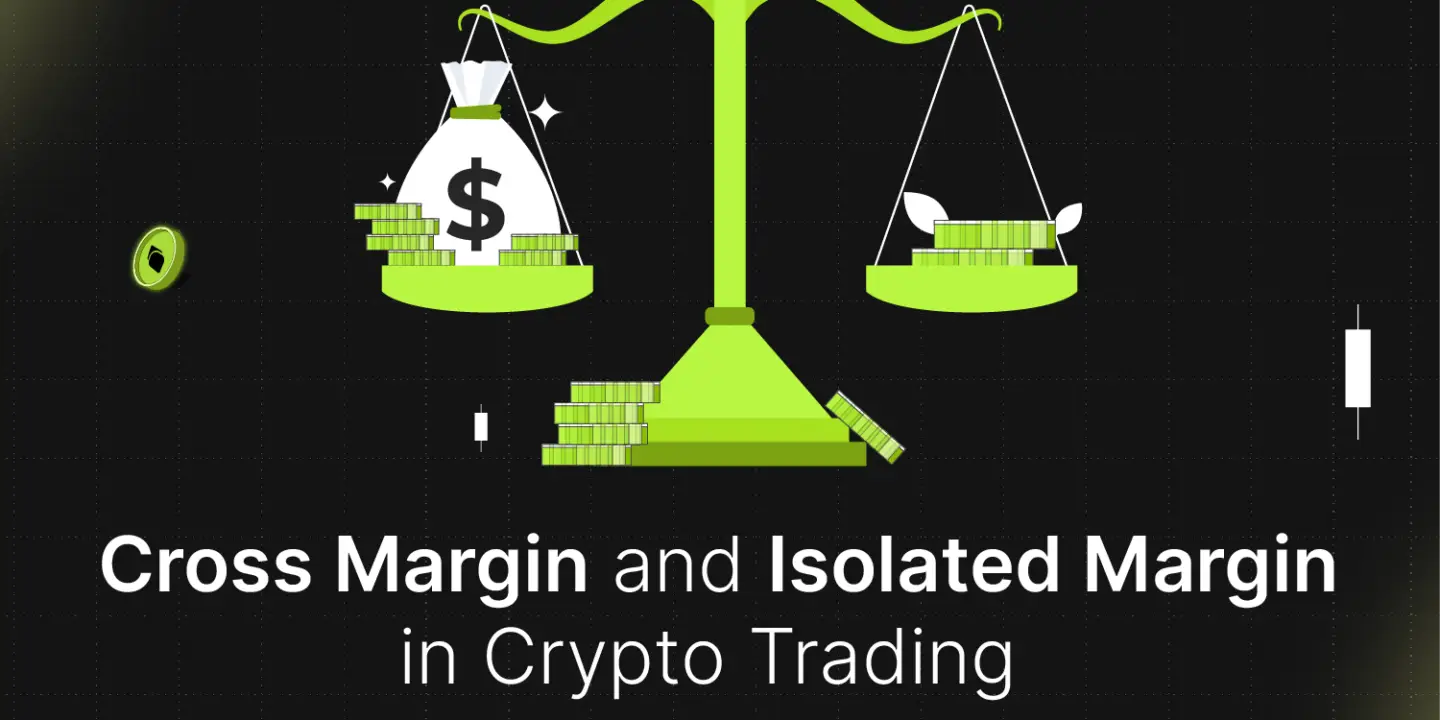
If you trade crypto with leverage, you’ve probably come across the terms cross margin and isolated margin. These two methods define how collateral is allocated to your trades and how much risk you are taking on each position.
Understanding cross margining vs isolated margin is essential for both new and experienced traders. The choice you make can determine whether your account survives volatility or faces liquidation.
This guide breaks down what cross margin and isolated margin are, their key differences, pros and cons, and when to use each. We’ll also cover related terms like cross-product margining and explain what “cross 10x” means in crypto trading.
Understanding Margin Trading
Before comparing cross vs isolated margin, it’s important to understand what margin trading is.
- Margin trading allows you to borrow funds from an exchange to open a position larger than your account balance.
- Leverage refers to the ratio of borrowed funds to your own capital (e.g., 10x leverage means $100 of your own funds lets you trade a $1,000 position).
- Margin is the collateral you provide to back your leveraged trades.
Platforms like Bitunix offer leverage up to 125x, giving traders significant buying power. While leverage amplifies profits, it also magnifies losses, making proper risk management critical.
What is Cross Margin in Crypto Trading?
Cross margin is a method where your entire account balance is shared as collateral across all open positions.
- All funds in your margin account back every trade.
- Profits from one position can offset losses in another.
- If liquidation occurs, your entire balance is at risk.
This is why cross margining is often compared to a safety net: profits and losses are distributed across your portfolio.
Example:
You have $1,000 in your margin account and open 3 trades (BTC, ETH, XRP). If BTC drops, but ETH and XRP rise, the profits from ETH/XRP can cover BTC losses, reducing the chance of liquidation.
Key Features of Cross Margin
- Shared Risk and Reward: All positions use one collateral pool.
- Automatic Fund Allocation: The system redistributes margin automatically between positions.
- Lower Immediate Liquidation Risk: Because the balance is shared, liquidation is less likely unless all positions turn negative.
What is Isolated Margin?
Isolated margin allocates a fixed amount of margin to each trade.
- Each position has its own dedicated collateral.
- Losses are limited to the amount assigned to that trade.
- Other funds in your account remain safe.
Example:
With $1,000 in your account, you allocate $500 to BTC, $300 to ETH, and $200 to XRP. If BTC drops and is liquidated, you only lose $500 — the ETH and XRP funds remain unaffected.
Key Features of Isolated Margin
- Individual Risk Control: Each position’s risk is capped.
- Manual Fund Allocation: You must actively assign collateral to trades.
- Higher Liquidation Risk Per Position: If the margin is too small, one position can be liquidated quickly.
Cross Margin vs Isolated Margin: Key Differences
Here’s a direct cross vs isolated margin comparison:
| Feature | Cross Margin | Isolated Margin |
| Collateral | Shared across all positions | Dedicated to each position |
| Risk Exposure | Entire account balance at risk | Only allocated margin at risk |
| Liquidation | Less frequent but higher total loss potential | More frequent but limited to one position |
| Fund Allocation | Automatic by the system | Manual by the trader |
| Best For | Experienced traders managing multiple trades | Beginners or risk-averse traders |
What Does “Cross 10x” Mean?
When you see “cross 10x” on a trading panel:
- Cross means your entire balance is collateral for the position.
- 10x means you’re trading with leverage 10 times your capital.
Example:
With $100 in your account on cross 10x, you can open a $1,000 position. If the trade goes against you, all $100 in your balance is at risk.
What is Cross-Product Margining?
Cross-product margining is a method used in futures trading where margin is shared across different product types (e.g., futures, options, swaps).
In crypto, this may mean collateral from one contract type can support another. While not every platform offers it, it’s common in traditional futures markets and increasingly relevant for advanced crypto exchanges.
Pros and Cons of Cross Margin vs Isolated Margin
Cross Margin
✅ Pros
- Flexible, profits offset losses.
- Lower immediate liquidation risk.
- Convenient automatic margin allocation.
❌ Cons
- Entire account balance at risk.
- Complex to manage for beginners.
Isolated Margin
✅ Pros
- Risk is capped per position.
- Easier for beginners to understand.
- Protects overall account balance.
❌ Cons
- Higher chance of liquidation for individual trades.
- Requires manual monitoring and adjustments.
When Should a Trader Choose Cross Margin or Isolated Margin?
- Cross Margin: Best for experienced traders managing multiple positions, those who want automatic fund allocation, and traders confident in their strategy across several assets.
- Isolated Margin: Best for beginners, risk-averse traders, or anyone who wants to limit losses to a single trade.
Most Reliable Brokers for Cross-Margin Accounts in Futures
If you want to use cross margining in futures trading, choose platforms with proven reliability. The most reliable brokers for cross-margin accounts are exchanges that:
- Offer proof of reserves and strong audits.
- Provide clear margin policies.
- Have transparent risk management tools.
Bitunix, for example, provides both cross margin and isolated margin with up to 125x leverage, advanced risk management, and 24/7 security monitoring.
Practical Tips for Managing Margin Trading
- Always set stop-loss orders to protect capital.
- Use lower leverage in volatile markets.
- Diversify positions across assets to reduce risk.
- Regularly monitor margin levels and top up when necessary.
- Start with isolated margin if you’re a beginner, then transition to cross margin once experienced.
Conclusion
Both cross margin and isolated margin are valuable tools in crypto trading, but they serve different purposes.
- Cross margining offers flexibility by pooling funds and letting profits offset losses, but it exposes your entire account.
- Isolated margin limits losses to one position, protecting the rest of your account, but requires more manual management.
Ultimately, the decision between cross margin vs isolated margin comes down to your risk tolerance, strategy, and experience level. Platforms like Bitunix allow you to use either, giving you the flexibility to trade in a way that best fits your goals.
FAQs
What is cross margining?
Cross margining is when your entire account balance is used as collateral for all trades. Profits and losses are shared across positions.
What is cross margin in crypto trading?
Cross margin in crypto ensures all positions draw from one margin pool. It reduces the risk of single-position liquidation but puts your whole balance at risk.
What are the key differences between cross margin and isolated margin?
Cross margin shares one pool of collateral across all trades, while isolated margin allocates funds separately per trade. Cross reduces frequent liquidation, but isolated limits losses per position.
What is cross-product margining?
Cross-product margining allows traders to use one margin pool for multiple product types (like futures and options), optimizing capital usage.
What does cross 10x mean?
Cross 10x means you’re using cross margin with 10x leverage — all account funds can be liquidated if the position goes against you.
Pros and cons of cross margin vs isolated margin?
Cross margin offers flexibility and fewer liquidations but risks the whole balance. Isolated margin protects your account but increases the chance of single-trade liquidation.
Which are the most reliable brokers for cross-margin accounts in futures?
The most reliable brokers provide proof of reserves, transparent margin policies, and advanced risk tools. Bitunix is one example offering up to 125x leverage with both cross and isolated options.
When should a trader choose cross margin or isolated margin?
Choose cross margin if you’re experienced and managing multiple trades. Choose isolated margin if you’re new, risk-averse, or want stricter loss control.
About Bitunix
Bitunix is one of the world’s fastest growing professional derivatives exchanges, trusted by over 3 million users across more than one hundred countries. Ranked among the top exchanges on major data aggregators, Bitunix processes billions in daily volume and offers a comprehensive suite of products including perpetual futures with high leverage, spot markets, and copy trading. Users can trade bitcoin and other major cryptocurrencies on the platform, taking advantage of advanced trading features. Known for its Ultra K line trading experience and responsive support, Bitunix provides a secure, transparent, and rewarding environment for both professional and everyday traders. Bitunix Academy adds structured lessons so you can build skills while you trade.
Bitunix Global Accounts
X | Telegram Announcements | Telegram Global | CoinMarketCap | Instagram | Facebook | LinkedIn | Reddit | Medium
Disclaimer: Trading digital assets involves risk and may result in the loss of capital. Always do your own research. Terms, conditions, and regional restrictions may apply.





